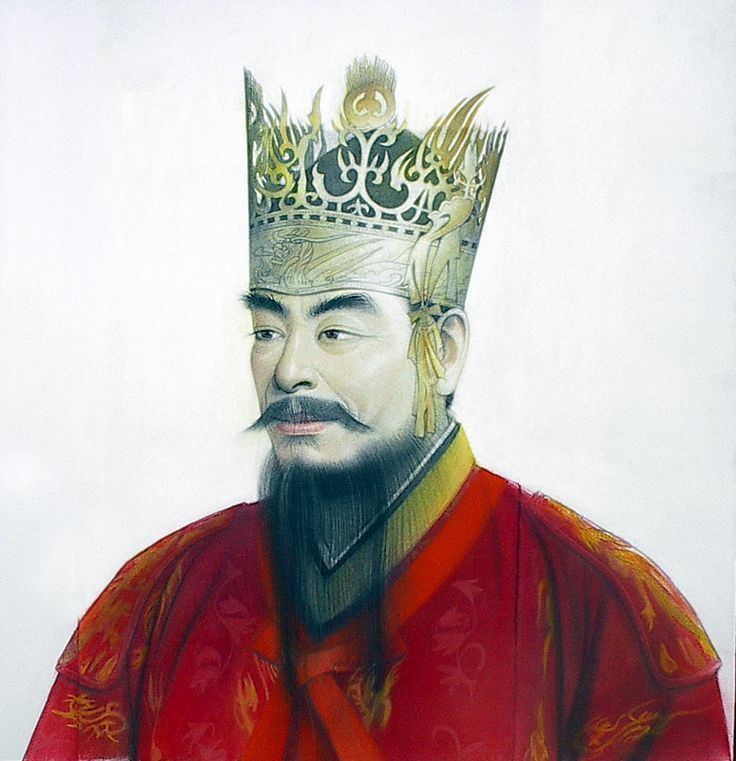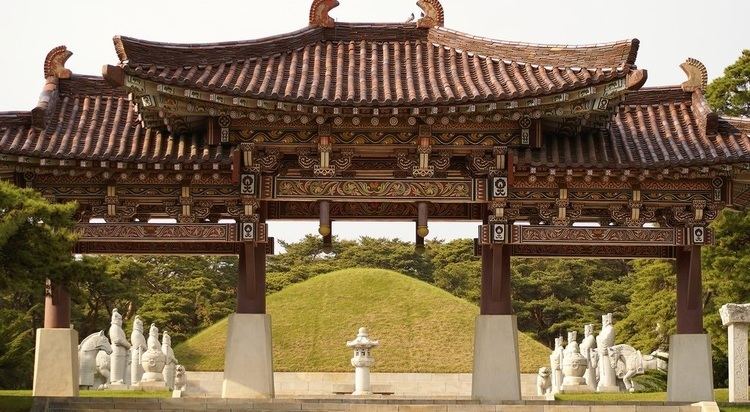Reign 37 BCE - 19 BCE Mother Yuhwa | ||
 | ||
Grandchildren Similar People | ||
Born 58 BCE (age 39) Died 19 BCE (aged 39) | ||
Popular Videos - Buyeo & Dongmyeong of Goguryeo
King Dongmyeong of Goguryeo (58 BCE – 19 BCE, r. 37 BCE – 19 BCE) or Dongmyeongseongwang (Hangul: 동명성왕; Hanja: 東明聖王), which literally means Holy King of the East, also known by his birth name Jumong (Hangul: 주몽; Hanja: 朱蒙), was the founding monarch of the kingdom of Goguryeo, the northernmost of the Three Kingdoms of Korea. In the Gwanggaeto Stele, he is called Chumo-wang (King Chumo). In the Samguk Sagi and the Samgungnyusa, he is recorded as Jumong with the surname Go. The Samguk Sagi states that he was also known as Chumo or Sanghae (Hangul: 상해; Hanja: 象解). The name is also transcribed in other records as Chumong (Hangul: 추몽; Hanja: 鄒蒙), Jungmo (Hangul: 중모; Hanja: 中牟 or hanja: 仲牟 ), or Domo (Hangul: 도모; Hanja: 都牟).
Contents
- Popular Videos Buyeo Dongmyeong of Goguryeo
- Popular Dongmyeong of Goguryeo Jumong videos
- Birth
- Rule
- Demise
- Legacy
- In popular culture
- Actors who have played Jumong
- Family
- References

Popular Dongmyeong of Goguryeo & Jumong videos
Birth

The founding myths of Goguryeo are related in ancient writings, including the Gwanggaeto Stele. The best-known version is found, with slight variations, in the Samguk Sagi, Samgungnyusa, and the "King Dongmyeong" chapter (Hangul: 동명왕편; Hanja: 東明王篇) of the Dongguk Yisang Gukjip (Hangul: 동국이상국집; Hanja: 東國李相國集).

There have been disputes over who the father of Jumong really was. In one legend Jumong is son of Hae Mo-su (Hangul: 해모수; Hanja: 解慕漱) and Lady Yuhwa (Hangul: 유화부인; Hanja: 柳花夫人), the daughter of the Chinese deity of the Yellow River Habaek (Hangul: 하백; Hanja: 河伯). Hae Mosu met Lady Yuhwa by a river where she was bathing, but Habaek disapproved of Hae Mosu, who returned to heaven. The river deity chased Lady Yuhwa away to Ubal river (Hangul: 우발수; Hanja: 優渤水), where she met and became the concubine of King Geumwa of Eastern Buyeo. Lady Yuwha was impregnated by sunlight and gave birth to an egg. Geumwa tried to destroy the egg, and tried to feed it to animals, who instead protected the egg from harm. Geumwa returned it to Lady Yuhwa. From the egg hatched a baby boy, who was named Jumong, meaning "skilled archer" in the ancient Buyeo language.

Leaving Eastern Buyeo, Jumong was known for his exceptional skill at archery . Eventually, Geumwa's sons Daeso and Yongpo became jealous of him, and Jumong left Buyeo to follow Hae Mo-su's dream to unify Gojoseon territories which had been broken up as a result of the Han Dynasty's corrupt government and rescue Gojoseon's population that had been left in Eastern Buyeo. According to legend, as he fled on his horse, he approached a fast-running river. Turtles and creatures of the water rose up and formed a bridge. He entered the land south of the river. In 37 BCE, Jumong became the first king of Goguryeo, and reunited all of the five tribes of Jolbon into one kingdom. Soseono, who was a Jolbon chief's daughter, became his second wife and gave birth to his son, who eventually established the kingdom of Baekje as Onjo of Baekje.
Rule

In 37 BCE, Jumong and his second wife Soseono established Goguryeo and became its first King and Queen. During that same year, King Songyang (Hangul: 송양; Hanja: 松讓) of Biryu surrendered to him after receiving assistance in defeating the Mohe people's invasion. In 34 BCE, along with the palace, Goguryeo's first capital city Jolbon, was completed. Four years later, in 28 BCE, Jumong sent General Bu Wiyeom (Hangul: 부위염; Hanja: 扶尉厭) to conquer the Okjeo. During that same year, Jumong's mother, Lady Yuhwa, died in the palace of the Eastern Buyeo, and was given the burial ceremony of a queen consort even though she was only a concubine.
Jumong sent a messenger and numerous gifts to King Geumwa in gratitude for King Geumwa's generosity. In 19 BCE, Jumong's first wife Lady Ye, fled Eastern Buyeo with their son Yuri to Goguryeo. At that time, Jumong's second wife Soseono was queen. When Lady Ye and Yuri arrived in Goguryeo, Soseono gave up her title after realizing that Jumong would make Yuri the Crown Prince and decided to leave Goguryeo. Soseono left Goguryeo with her two sons and some of her subordinates and headed further south into the Korean Peninsula into what is now South Korea. There she established Baekje. Jumong elected his first son, Yuri as the successor to the throne.
Demise
Jumong died in 19 BCE at the age of 40. Crown Prince Yuri buried his father in a pyramid tomb and gave him the posthumous name "Holy King Jumong".
Legacy
Jumong's kingdom of Goguryeo eventually evolved into a great regional territory with considerable power and influence. Goguryeo stood for 705 years and was ruled in total by 28 consecutive emperors in the Go Dynasty until it was conquered by the Silla-Tang alliance in 668. Balhae and Goryeo succeeded it, and the modern descendants of Jumong still bear his family name "Go."
In Goguryeo, Jumong was deified into an ancestral deity and he was worshipped in the Temple of King Dongmyeong next to his tomb.
In popular culture
From 2006 to 2007, MBC aired a highly popular 81 episode drama, Jumong, to mark their anniversary. The series took elements from historical records and mythology, and retold the story in a more down to earth manner than found in the myths, recounting how Jumong, the spoiled step-child of the Buyeo royal family, embarks on a journey of self-discovery, becoming a leading figure of Buyeo, but retreating from Buyeo after his step-brothers' betrayal. Relaunching the armed and militarily capable guerrilla fighters' force his biological father Hae Mo-su once headed, Jumong goes on a life-mission to rescue and band together the refugees of the ancient Joseon peoples, leading the fight against the oppression of Imperial China, finally establishing himself as the king of the new nation Goguryeo.
From 2010 to 2011, KBS1 aired King Geunchogo, also known as The King of Legend. In this series, Jumong is portrayed as a tyrant, who could not accept sharing the power over Goguryeo with Soseono and the Jolbon faction. After Yuri of Goguryeo's arrival, the declared crown prince and successor to Jumong's throne, Soseono and all her subordinates and servants decided to leave "their beloved Goguryeo" to establish a new kingdom - one "much more powerful than Goguryeo ever was."
Actors who have played Jumong
Family
- Yuri of Goguryeo
- Biryu
- Onjo of Baekje
